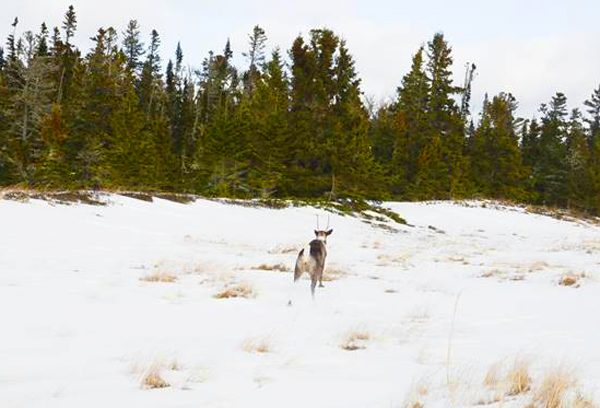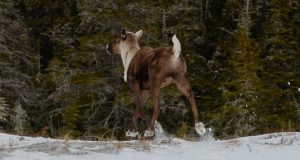Mar 6, 2018 @ 18:56
Q: What is the current status of the caribou around Lake Superior?
A: Not good. The caribou on the mainland may now be all gone. Recently, there were still thought to be some along the north shore from Pic Island to west of Cape Victoria (Marathon to Rossport). But local residents say no one has seen any animals or sign there for a few years now. The Slate Islands used to have a high population, but a pair of wolves went out to the islands in 2014 and eliminated all the caribou there except for 2 to 4 bulls. Michipicoten Island also had a very large caribou population (likely well over 800 and maybe close to 1000), but wolves also went out to there in 2014 and have almost eliminated the caribou. In an attempt to salvage the population from extirpation, the MNRF moved 9 caribou to the Slates from Michipicoten in January, and 5 caribou to Caribou Island from Michipicoten in February in partnership with the Michipicoten First Nation. So when the Michipicoten Island caribou are gone this winter, there will only be 16 to 18 caribou left in the Lake Superior population. That’s down from close to 1000 animals 4 years ago.
Q: What is being done to prevent the loss of the Lake Superior caribou?
A: The Michipicoten First Nation and a handful of local people have been pushing the MNRF to act to conserve the Lake Superior caribou. Many of you also wrote to the Ministry or your MPP about this – so public pressure undoubted helped – thank you. As a result, the MNRF have arranged 2 caribou moves to salvage the population:
- Slate Islands move: 8 female and 1 male caribou were moved from Michipicoten Island back to the Slate Islands in mid-January. That will temporarily re-establish the Slate Islands population. But it remains at high risk because wolves regularly reach the Slates. From 2014 to 2017 only a pair of wolves was able to functionally extirpate the caribou there – leaving only the 2 to 4 bulls. This is also called sex extirpation – where one sex is eliminated (in this case all the females) so the population cannot perpetuate itself.
- Caribou Island move: In partnership with the Michipicoten First Nation, 4 female and 1 male caribou were moved from Michipicoten Island to Caribou Island in mid-February. As the most remote island on the Great Lakes, it is ideal for a backup population of the Lake Superior caribou – wolves are very unlikely to reach it. Efforts are ongoing to try to get the MNRF to continue with the move to get 1 or 2 more bulls to provide genetic diversity, reduce inbreeding, and help secure the population.
Q: What’s next with the Lake Superior caribou?
A: In the short term, we are still pushing the MNRF to move 1 or ideally 2 more bulls to Caribou Island to augment the 1 lone bull there now. There are 3 main reasons for this:
- Genetic Diversity – The idea is to get as much of the genetic diversity from Michipicoten Island as we can. There was already 1 bull from the mainland on Michipicoten Island when the other caribou were moved there in 1982. That means the Michipicoten Island caribou have the only mainland Lake Superior genetics left. In particular, some of the bulls on Michipicoten will have the only Y chromosomes left from the mainland caribou. Genetics reflects fitness to the environment, so these animals are the best stock available for any future restoration of caribou on the mainland around Lake Superior.
- Avoid/Minimize Inbreeding – Having other bulls is the only way to prevent all of the calves for the next few years from being half-brothers and half-sisters. This would reduce the risk of detrimental traits from inbreeding becoming established early in the population.
- Population Security – Moving other bulls assures that breeding can continue for the next few years and get this backup population established. As it stands now, we are hoping that a male calf is born this spring, but it will not breed until it is 3 or 4. If something happens to the first bull, or if no male calves are born this spring, a backup bull (or ideally 2) ensures that the population can be established successfully.
If you would like to help out with the conservation of the last of the Lake Superior caribou, please write to Nathalie Des Rosiers, the Minister of Natural Resources and Forestry and ask her to move another 1 or 2 caribou bulls to Caribou Island to secure the backup population of the Lake Superior caribou. There are not many caribou left on Michipicoten Island so write her today. Her email address is:
To read more information about the Lake Superior Woodland Caribou click here.
- Mixed Curling Standings – December 13 - December 13, 2025
- Ladies Curling Standings – December 12th - December 12, 2025
- Municipality of Wawa Partners with SECFDC to Administer Municipal Accommodation Funds - December 10, 2025
 Wawa-news.com You can't hear the 'big picture'!
Wawa-news.com You can't hear the 'big picture'!

